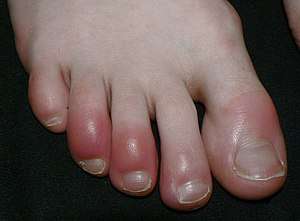Chilblains
Chilblains, also known as pernio and chill burns[2] are a medical condition that occurs when a predisposed individual is exposed to cold and humidity. Damage to capillary beds in the skin causes blood to perfuse into the nearby tissue too quickly,[3] resulting in redness, itching, inflammation, and blisters.[4] Chilblains can be reduced by keeping the feet and hands warm in cold weather, and avoiding extreme temperature changes.
| Chilblain | |
|---|---|
| Other names | Pernio, chill burn, perniones, perniosis[1] |
 | |
| Toes inflamed by chilblains | |
| Pronunciation |
|
| Specialty | Emergency medicine |
COVID-19 may also cause chilblain-like symptoms[5][6] (sometimes called 'COVID-toes'[7]), mostly in older children and adolescents.[8] They tend to be delayed symptoms that are usually mild and disappear without treatment.[8]
Chilblains can be idiopathic (spontaneous and unrelated to another disease), but may also be a manifestation of another serious medical condition that must be investigated. Related medical conditions include Raynaud's disease, erythromelalgia, frostbite, trench foot, as well as connective tissue diseases such as lupus or vasculitis.
In infants, chilblains together with severe neurologic disease and unexplained fevers occurs in Aicardi–Goutières syndrome, a rare inherited condition. Ulcerated chilblains are referred to as kibes.
Signs and symptoms

The areas most affected are the toes, fingers, earlobes, nose.
- Blistering of affected area
- Burning and itching sensation in extremities
- Dermatitis in extremities
- Ulceration (severe cases only)
- Erythema (blanchable redness of the skin)
- Pain in affected area
- Skin discoloration, red to dark blue
Chilblains caused by exposure to low temperatures usually heal within 7–14 days.
Prevention
Exposure
- Keep affected area warm, and avoid any extreme temperature changes (including very hot water).[3]
Treatment
Treatment for the condition depends on its cause. Below are some common treatments for chilblains caused by exposure to low temperatures, though some may also apply to other sources of the condition.
- A course of vitamin B, especially nicotinic acid, may improve circulation .
- Soaking in warm water with Epsom salts for 15–20 minutes, 3–4 times a day.
- A topical steroid cream may relieve itching.
- Nifedipine, a vasodilator, may help in some cases.[11] Vasodilation may reduce pain, facilitate healing, and prevent recurrences.[12] It is typically available in an oral pill but can be compounded into a topical formula.
- Diltiazem, a vasodilator, may help.[13]
- Apply a mixture of friar's balsam and a weak iodine solution.[9]
- Avoid restricting the affected area.[14]
History
The medieval Bald's Leechbook recommended treating chilblains with a mix of eggs, wine, and fennel root,[15] and a modern home remedy is to put garlic on the chilblains.[16] Neither of these remedies has been supported by scientific research.
See also
- Equestrian perniosis
- Erythrocyanosis crurum
- Raynaud's disease
References
- James, William D.; Berger, Timothy G.; et al. (2006). Andrews' Diseases of the Skin: clinical Dermatology. Saunders Elsevier. ISBN 978-0-7216-2921-6.
- SJ; et al. SJ'.
- Harvard.edu. https://www.health.harvard.edu/newsletter_article/what-can-i-do-about-chilblains. Retrieved 31 May 2020. Missing or empty
|title=(help) - Cold Stress: Chilblains. National Institute for Occupational Safety and Health. Retrieved January 6, 2009.
- Wollina U, Karadağ AS, Rowland-Payne C, Chiriac A, Lotti T (2020). "Cutaneous Signs in COVID-19 Patients: A Review" (PDF). Dermatologic Therapy. doi:10.1111/dth.13549. PMID 32390279.
- Young S, Fernandez AP (2020). "Skin manifestations of COVID-19". Cleveland Clinic Journal of Medicine. doi:10.3949/ccjm.87a.ccc031. PMID 32409442.
- Caitlin O'Kane (30 April 2020). ""COVID toes" and other skin symptoms may be a sign of coronavirus". CBS News.
- Walker DM, Tolentino VR (June 2020). "COVID-19: The impact on pediatric emergency care". Pediatric Emergency Medicine Practice. 17 (Suppl 6-1): 1–27. PMID 32496723.
- "What are chilblains (pernio)? What causes chilblains?". Medical News Today.
- "Chilblains.org - #1 Online Source for Treatments, Prevention, Relief Advice". Chilblains.org.
- Rustin, M.H.A.; Newton, Julia A.; Smith, N.P.; Dowd, Pauline M. (2006). "The treatment of chilblains with nifedipine: the results of a pilot study, a double-blind placebo-controlled randomized study and a long-term open trial". British Journal of Dermatology. 120 (2): 267–75. doi:10.1111/j.1365-2133.1989.tb07792.x. PMID 2647123.
- Simon, T. D.; Soep, JB; Hollister, JR (2005). "Pernio in Pediatrics". Pediatrics. 116 (3): e472–5. doi:10.1542/peds.2004-2681. PMID 16140694.
- Patra, AK; Das, AL; Ramadasan, P (2003). "Diltiazem vs. nifedipine in chilblains: A clinical trial". Indian Journal of Dermatology, Venereology and Leprology. 69 (3): 209–11. PMID 17642888.
- "Chilblains.com.au - Information, Treatment and Prevention". Archived from the original on 2016-03-05. Retrieved 2019-11-06.
- Robert Lacey and Danny Danziger August: The Year 1000: What Life Was Like at the Turn of the First Millennium Little, Brown, 2000 ISBN 0316511579
- "Remedios caseros para sabañones". saludplena.com (in Spanish). Retrieved 29 December 2016.
External links
| Classification | |
|---|---|
| External resources |
| Look up chilblains in Wiktionary, the free dictionary. |
| Wikimedia Commons has media related to Chilblains. |
- Cold stress, National Institute for Occupational Safety and Health